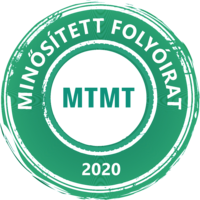Challanges of sustainable food technology - A review
DOI:
https://doi.org/10.14232/analecta.2020.1.118-129Keywords:
Sustainable food technology, LCA method, Protein, Waste valorisationAbstract
Over the last decades due to rapid development of human civilization along with revolution in technology, some burning issues about generation of environmental contaminant, management of by-products from technologies, high consumption of natural resources and conservation of natural resources have been dramatically raised. Without any contradiction, impacts in overall ecosystem as well as human civilization have negative effects. These evoked lots of scientific and industrial researches, and implemented several stricter environmental legislations on the development of sustainable ecosystem. Thus, sustainability has become an emerging topic all over the world, as evidenced by the growing body of scientific publications in the last 20 years with one order of magnitude increase since the start of the new century. The study attempts to perform a review ty is an emerging topic all over the world of the sustainable development from the food industry’s perspective. At present, the agro-food sector produces high amount of carbon dioxide, food waste, packaging waste, wastewater, etc. and it is still consuming a lot of water, land, oxygen and energy. Furthermore, taken into consideration the increasing number of the world’s population, there has been an enhancing interest experienced towards sustainable development among food manufacturers in the last decades. The article highlights the paramount areas of sustainable production, which offers new directions towards the increasing number of human beings for the future survival. The paper also gives an overview of the main perspectives contra constraints of sustainable food production, offers innovative food products from sustainable food waste and by-product, and focuses on the growing importance of sustainable food production in life cycle assessment methodology as well.
Downloads
References
Fasolin, L.H., Pereira, R.N., Pinheiro, A.C., Martins, J.T., Andrade, C.C.P., Ramos, O.L. & Vicente, A.A. (2019): Emergent food proteins – Towards sustainability, health and innovation., Food Research International, 125, 1-16.
Bora, Gy. & Korompai, A. (2003): The economy and geography of natural resources, Aula Publisher, Budapest
Ekman, A., Campos, M., Lindahl, S., Co, M., Börjesson, P., Nordberg Karlsson, E. & Turner, C. (2013): Bioresource utilisation by sustainable technologies in new valueadded biorefinery concepts - two case studies from food and forestindustry., Journal of Cleaner Production, 57, 46-58.
Szlávik, J. (2013): Sustainable economics (Fenntartható gazdálkodás), Wolters Kluwer Kiadó, Budapest
Brundtland committee (1987): Report of the World Commission on Environment and Development. Our Common Future, Annex to document A/42/427 - Development and International Cooperation: Environment, United Nations.; https://sustainabledevelopment.un.org/content/documents/5987our-common-future.pdf
Brown, B., Hanson, M., Liverman, D. & Merideth, R. (1987): Global sustainability: toward definition, Environmental Management 11 (6), 713-719.
United Nations The Sustainable Development Goals Report (2018) https://unstats.un.org/sdgs/files/report/2018/TheSustainableDevelopmentGoalsReport2018-EN.pdf
NÉBIH (2016): https://portal.nebih.gov.hu/-/huvelyesek-nemzetkozi-eve-2016
Cakmak, I. (2002): Plant nutrition research: Priorities to meet human needs for food in sustainable ways., Plant and Soil,247, 3-24.
Hekstra, G. & Liverman, D. (1986): Global food futures and desertification., Climate Change, 9 (1,2); 59-68.
Gaffney, J., Bing, J.W., Byrne, P.F., Cassman, K.G., Ciampitti, I.A., Pierson Delmer, D., Habben, J.E., Lafitte, H.R., Lidstrom, U.E., Porter, D., Sawyer, J.E., Schussler, J., Setter, T.L., Sharp R.E., Vyn T.J. & Warner, D. (2019): Science-based intensive agriculture: Sustainability, food security, and the role of technology; Global Food Security, 23, 236-244.; (DOI:10.1016/j.gfs.2019.08.003)
Brklacich, M., Bryant, C. & Smit, B. (1991): Forum: Review and Appraisal of Concept of Sustainable Food Production Systems., Environmental Management (Springer-Verlag New York Inc.), 15 (1), 1-14.
Van der Goot, A.J. (2017): Directions towards more sustainable food production, Targeted Technologies for Sustainable Food Systems: Outcomes from the EFFoST Annual Meeting Vienna, Austria., Trends in Food Science & Technology, 62, 228-233. http://dx.doi.org/10.1016/j.tifs.2017.01.006
Jagustovića, R., Zougmoréb, R. B., Kesslera, A., Ritsemaa, C. J., Keesstraa S., Reynoldsca, M., (2019) Contribution of systems thinking and complex adaptive system attributes to sustainable food production: Example from a climate-smart village, Agricultural Systems 171, pp.65-75
Jermann, C., Koutchma, T., Margas, E., Leadley, C. & Ros-Polsk, V. (2015): Mapping trends in novel emerging food processing technologies around the world. Innovat. Food Sci. Emerg. Technol., 31, 14-27., https://doi.org/10.1016/j.ifset.2015.06.007.
Knorr, D., Froehling, A., Jaeger, H., Reineke, K., Schlueter, O. & Schoessler, K. (2011): Emerging technologies in food processing. Annu. Rev. food Sci. Technol., 2, 203-235.
Töpfl, S., Smetana, K., Aganovic, C., Pernutz, L., Van Campenhout, A., Mathys, H., Katz, N. Gianotten, V. Heinz (2016): Insects as a more sustainable source of feed and food proteins: modelling supply chains through the lens of Life Cycle Assessment, Targeted Technologies for Sustainable Food Systems: Outcomes from the EFFoST Annual Meeting Vienna, Austria., Trends in Food Science & Technology, 62, 228-233.; http://dx.doi.org/10.1016/j.tifs.2017.01.006
Horizon (2016): BIO BASED INDUSTRIES PPP, Call ID:H2020-BBI-JTI-2016
Arcadis (2009): Assessment of the Options to Improve the Management of Bio-waste in the European Union, Annex D: Industrial Biowaste. ARCADIS Project number – 11/004759, Version A. European Commission DG Environment, Brussels, Belgium; https://ec.europa.eu/environment/waste/compost/pdf/ia_biowaste%20-%20final%20report.pdf
Yue, A.S., Munira, I.U., Hyderb, S., Nassanic, A.A., Moinuddin Qazi Abroc, M., Zamand, K. (2020): Sustainable food production, forest biodiversity and mineral pricing: Interconnected global issues,; Resources Policy, 65, 101583, 1-10.
Galanakis, C.M. (2012). Recovery of high added-value components from food wastes: Conventional, emerging technologies and commercialized applications. Trends in Food Science & Technology, 26(2), 68–87. (doi:10.1016/j.tifs.2012.03.003)
Stone, J., Garcia-Garcia, G. & Rahimifard, S. (2019): Development of a pragmatic framework to help food and drink manufacturers select the most sustainable food waste valorisation strategy, Journal of Environmental Management, 247, 425-438. https://doi.org/10.1016/j.jenvman.2019.06.037
Laufenber, G., Kunz, B. & Nystroem, M. (2003): Transformation of vegetable waste into value added products; (A) the upgrading concept; (B) practical implementation., Bioresour. Technol., 87., 167-198.
Henchion M., Hayes M, Mulle A.M., Fenelon M, Tiwari B. (2017) Future Protein Supply and Demand: Strategies and Factors Influencing a Sustainable Equilibrium Journal of Insects as Food and Feed, 6 (1)- Pages: 27 – 44, ISSN: 2352-4588
Henchion, M.; De Backer, C.; Hudders, L. (2017) Ethical and sustainable aspects of meat production; Consumer perceptions and system credibility. In Meat Quality Aspects: From Genes to Ethics; Purslow, P., Ed.; Elsevier: Cambridge, MA, USA, 2017.
Elzoghby, A.O., Samy, W.M. & Elgindy, N.A. (2012): Protein-based nanocarries as promosing drug and gene delivery systems., Journal of Controlled Release, 161(1), 38-49.; https://doi.org/10.1016/j.jconrel.2012.04.036
Sudarshan R. Nadathur, Janitha P.D. Wanasundara and Laurie Scanlin (2016) Sustainable Protein Sources, Academic Press, ISBN 978-0-12-802778-3, https://doi.org/10.1016/C2014- 0- 03542-34
Van Huis, A.; Van Itterbeeck, J.; Klunder, H.; Mertens, E.; Halloran, A.; Muir, G.; Vantomme, P. (2013) Edible Insects: Future Prospects for Food and Food; Food and Agriculture Organisation of the United Nations: Rome, Italy
Smetana, S.; Palanisamy, M.; Mathys, A.; Heinz, V. (2016) Sustainability of insect use for feed and food: Life Cycle Assessment perspective. J. Clean. Prod., 137, 741–751. (Google Scholar)
Klunder, H.C.; Wolkers-Rooijackers, J.C.M.; Korpela, J.M.; Nout, M.J.R. (2012) Microbiological aspects of processing and storage of edible insects. Food Control, 26, 628–631.
Belluco, S.; Losasso, C.; Maggioletti, M.; Alonzi, C.C.; Paoletti, M.G.; Ricci, A. (2013) Edible insects in a food safety and nutritional perspective: A critical review. Compr. Rev. Food Sci. Food Saf., 12, 296–313.
Meynard, J.M., Jeuffroy, M.H., Le Bail, M., Lefèvre, A., Magrini, M.B. & Michon, C. (2017): Designing coupled innovations for the sustainability transition of agrifood systems., Agric.Syst., 157, 330–339.
Woodhouse, A., Davis, J., Pénicaud, C. & Östergren, K. (2018): Sustainability checklist in support of the design of food processing.; Sustainable Production and Consumption, 16, 110–120.; https://doi.org/10.1016/j.spc.2018.06.008
Roy, P., Nei, D., Orikasa, T., Xu, Q.Y., Okadome, H., Nakamura, N. & Shíina T. (2009) A review of life cycle assessment (LCA) on some food products, J. Food Eng,.90., 1-10.
Silva, V.L. & Sanjuán, N. (2019): Opening up the black box: A systematic literature review of life cycle assessment in alternative food processing technologies., Journal of Food Engineering, 250, 33-45.; https:/doi.org/10.1016/j.foodeng.201901.010
Miglietta, P.P., Leo, F.D., Ruberti, M. and Massari, S., 2015. Mealworms for food: a water footprint perspective. Water 7: 6190-6203
Oonincx, D.G.A.B., Van Huis, A. and Van Loon, J.J.A.,(2015) Nutrient utilisation by black soldier flies fed with chicken, pig, or cow manure. Journal of Insects as Food and Feed 1: 131-139. https://doi.org/10.3920/JIFF2014.0023
El Bilali, H. & Sadegh Allahyari, M. (2018): Transition towards sustainability in agriculture and food systems: Role of information and communication technologies., Information processing in agriculture, 5, 456-464.; http://doi.org/10.1016/j.inpa.2018.06.006
Secchi M., Collina E., Castellani V., Mirabelly N., 2017., Assessing eco-innovations in green: LCA of a cosmetic product with a bio-based ingredient, Journal of Cleaner Production, April 2016, DOI: 10.1016/jclepro.2016.04.073
Internet 1: https://www.emi-tuv.hu/elelmiszerek-laboratoriumi-vizsgalata-es-tanusitasa
Mæhre, H.K, Dalheim, L, Edvinsen G.K, Elvevoll, E.O, Jensen, I-J. (2018) Protein Determination—Method Matters Foods; 7(1): 5. doi: 10.3390/foods7010005
Bollag D.M, Rozycki M.D, Edelstein S.J (1996.) Protein Methods, 2 ed., Wiley Publishers. ISBN 0-471-11837-0
UN (2016) https://www.un.org/sustainabledevelopment
A. van Hui (2019) Insects as food and feed, a new emerging agricultural sector: a review, Journal of Insects as Food and Feed, 2020; 6(1): 27-44 Wageningen Academic Publishers, SPECIAL ISSUE: Insects to feed the world
Downloads
Published
How to Cite
Issue
Section
License
Copyright (C) 2024 Authors
This work is licensed under a Creative Commons Attribution 4.0 International License.













